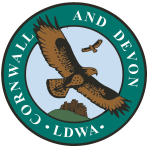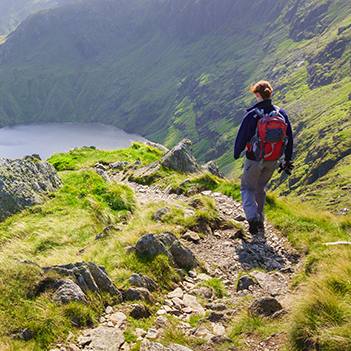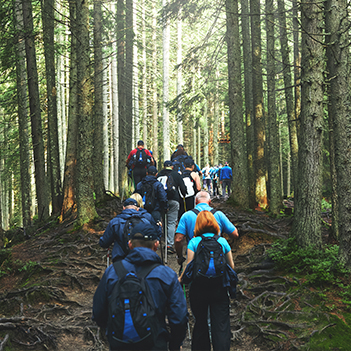Guide to Leading Walks in Devon & Cornwall
Leading a Walk - Useful Hints & Tips for Walk Leaders
This Guide is based on the LDWA's "Guidelines for Leading Social Walks - March 2022", with specific amendments for Cornwall & Devon.
Cornwall & Devon has some of the finest walking in Britain. LDWA members travel from all over the country to join our walks - we want to ensure that all our walks are safe, enjoyable and fulfilling.
Think of a walk!
- we have three Walks Coordinators who liaise with Walk Leaders to agree routtes, set dates, and most importantly, publicise walks
- once you've decided to lead a walk, and have a rough idea of where and when, then please email the Walks Coordinator for that area
- they will agree with you: an outline route, a rough length, a suitable start/finish location with adequate parking, and optional public transport links
- we have a growing database of past walks - your Walks Coordinator will be able to suggest recycling an earlier walk
- Cornwall & Devon offer a 20 mile walk on the 3rd Sunday of every month. However we also welcome shorter walks, on your choice of day
Plan your walk
- Work out your detailed route on 1:50,000 or 1:25,000 maps with possible alternatives. This should be on rights of way, permissive paths or open access land (unless you get specific permission to cross private land)
- Unless you are very familiar with the route, recce the route. If appropriate, consider alternatives that circumvent difficulties, or improve the walk, or even provide escape routes that could be useful under certain circumstances
- When you recce the route, its good practice to record a GPX on your smartphone (more and more members like to use their smartphones to view and follow routes). Don't worry if you're not familiar with this technology - we will be offering guidance on using this technology in the future
- Remember that paths that can be walked by an individual may not be suitable for a group; for example, very strenuous terrain, overgrown paths, sections of roads, paths through livestock areas or farmyards, traversing broken stiles etc
- Think where you might take breaks. Most walkers expect a morning coffee break, a lunch break and an afternoon tea break. If the weather is poor, will there be shelter? In fine weather will the walk pass any viewpoints worth a quick stop?
- To add interest, perhaps find out a little about historic buildings, wildlife locations, distant features etc, to tell your group
- If there's a pub near the finish, you might want to include its details (some members like to finish a walk with a pint)
- Most LDWA walks in Cornwall & Devon allow dogs on leads, but ultimately as Walk Leader, it's your decision (subject to any restrictions on the land you will be walking across)
- Do a basic 'risk assessment' (in your head or on paper) noting any potential hazards, with their level of risk and any measures to control them. For example: safe and adequate parking places; busy road crossings (regrouping, best place to cross); road or lane sections (single file on right or outside of bends); bad weather (alternative or escape routes); livestock (best line across fields); stream crossings (best crossing place, helping unsure walkers); difficult terrain (best line, slow pace); accidents (procedure for summoning help, basic first aid). Note that written Risk Assessments are an optional requirement for the LDWA
Publicising your walk
- We publish all our walks in the LDWA Magazine (Strider), on the Cornwall & Devon website; on our Facebook page and on our Meetup page and on the LDWA website
- You provide essential details to your Walks Coordinator: they organise all the publicity on your behalf. You will have to provide some contact details (usually email) and respond to queries from prospective walkers
- Essential details include: a memorable name of the route, date and time; start/finish location with car parking details and six figure OS reference; distance, terrain type and whether, moderate or strenuous.
- Decide on the maximum size of the group you wish to lead
- We offer all our walks to LDWA members, and to non-members via Meetup. LDWA members get priority and will often let you know beforehand if they are coming. Meetup people will also usually RSVP. But some people only decide an the day, and there may be no-shows. Typically, you will get between 12 and 20 people turning up. You need to decide what is the maximum size of group you are comfortable. Your Walks Coordinator can advise here
The day beforehand
- Check the weather forecast and consider any consequent changes to the route
- Ensure that your own equipment is more than adequate, remembering that you may have to cope with an emergency. In particular, carry a bivvy bag, mobile phone, food and drink, spare clothing (if it's cold there are often those who want to borrow gloves or a hat), etc.
- Ensure you have your map and waterproof map case. If you plan to navigate with your smartphone, ensure you have the correct GPX available, that your phone is charged and that you have a spare charging block
At the start
- Arrive at least 15 minutes before the start time to welcome walkers, particularly newcomers, and advise on parking as necessary
- You must complete a Social Walk Register form - its a requirement of the LDWA insurance. You could get another walker to do it for you. Take a photo of the completed Form and email to your Coordinator or Group Secretary. They will upload to the LDWA website where it is kept for seven years
- Check (discretely) that everyone is adequately equipped. If you have a concern, you need to tactfully raise this with the individual. If they need to leave the walk early (because they don't have the right wet weather gear, or footwear), where might they leave? How would they get back to the start point? Would another member be prepared to accompany them to ensure their safety?
- If there are more than about five walkers, appoint a backmarker
- Immediately before the start, spend a couple of minutes telling the group about the walk (many walkers like to follow their progress on their maps or smartphones). Highlight any risky points (cliff edges, road crossings, busy roads, fields of cattle, mires). Mention arrangements for breaks, lunch and possible toilet stops
- Check your phone for late messages from people who couldn't find the start location/got stuck in traffic etc, and decide what action you might take (delay the start? ask them to meet at the first coffee break? tell them that you can't wait?)
- Count the group!
During the walk
- There are many styles of leadership – it's not necessary to be at the front all the time, though you should be when the route is difficult or not obvious and should ensure no-one gets too far ahead
- You do need to be able to navigate. Having said that, in poor visibility, following footpaths across farmed countryside and between villages is easier and less risky than traversing open moorland. The key point here is that your navigation skills need to be appropriate for where and when you are walking, and the weather conditions
- Be particularly alert at hazards such as road crossings, rough sections, livestock areas, etc
- Judging the right pace can be difficult: a reasonable rate of progress is needed but walkers should not feel unduly pushed
- Keep in touch visually with the backmarker and if necessary slow down or wait so the party does not get too spread out
- Consider waiting a little at stiles or gates to avoid the group becoming too spaced
- In mist, ensure that the group keeps close together. Slow down your pace if necessary
- Count the group from time to time to check no-one is missing (clearly a dedicated backmarker helps here).
- Make sure that you are aware of any walkers who decide to leave the walk for any reason
- At all costs avoid part of the group getting detached from the rest and perhaps going off the wrong way – attempting to get everyone back together can be time-consuming and frustrating for everyone
- Be prepared to shorten or modify the route if the state of the weather or the party make this wise
- Indicate how long each break will be and give a two-minute warning before restarting
- Try to talk to everyone, especially newcomers, during the course of the day
- It's a nice gesture (though certainly not obligatory) for the leader to hand round a bag of sweets or even cakes during a break
- Do your best to ensure that everyone enjoys the walk!
At the end of the walk
- Thank walkers for coming and remind them of the next walk
- Encourage newcomers to join the LDWA and come again, perhaps noting their contact details so that they can be informed of future walks
- If there have been any incidents such as injury or damage to property, ensure that an incident form is completed and returned to the LDWA Treasurer. Note that the LDWA has an insurance policy which covers third party liability. The policy is on the LDWA website and any queries should be made to the Treasurer
Possible problems
Emergencies: very occasionally there is a serious medical emergency, such as a walker collapsing or breaking a limb, and you have to decide what action to take – this will depend on the circumstances. The top priority is to get help by dialling 999 or 112 from a mobile or by dispatching someone to the nearest phone box or house. Whilst a grid reference is essential, other information such as access details may be needed, and someone may need to be sent to the nearest public road to meet an ambulance. Unless one of the group is trained in first aid, there may be little else that can be done until help arrives except keeping the casualty warm and providing reassurance. Particularly in bad conditions, a leader may appoint a deputy to lead most of the group to the finish of the walk whilst just a few wait at the incident scene.
First aid: all walkers are strongly encouraged to carry routinely personal first aid kits sufficient for minor problems. A leader may carry extra sterile dressings and bandages but current advice is that leaders should not give tablets, medication or creams to others. Those who lead walks regularly should consider taking one of the first aid courses offered by local St John Ambulance or Red Cross groups.
Bad conditions: if the weather deteriorates you should consider shortening the walk or diverting to a less exposed alternative.
The slow walker: if a walker is lagging, encouragement from the leader can be effective; however if such a walker feels inadequate they may slow even more. Occasionally someone may fall behind so much early on that it is obvious that he/she will not complete the route in a reasonable time. This needs to be pointed out to the person sooner rather than later, and options such as cut backs, bus options, etc, considered. If it is felt that an inexperienced walker cannot be left alone a member of the group may need to be found to accompany them.
The fast walker: sometimes a walker will persistently dash off far ahead (not always in the right direction) and be difficult to keep track of. Tactfully point out that, on a group walk, walkers are expected to stay with the group. Anyone not accepting this should be told to continue independently and under their own responsibility for route finding. On the other hand, if there is a section where walkers' paces are obviously going to vary, for example on a steep ascent, there is no harm in telling faster walkers to go ahead and wait at an obvious landmark, such as at the top of the hill.
The Country Code: any disregard for the Country Code can bring the LDWA into disrepute. Most walkers are aware of their responsibilities, but occasionally a walker may drop litter, etc, and you should point out politely but firmly that this is not acceptable. Ensure (in conjunction with the backmarker) that gates are left in their original state and that any dogs are properly under control; in particular dogs must be on leads anywhere near livestock however well-behaved the owner claims them to be. Should a group be challenged by a landowner or other countryside user be polite, calm and cooperative but without conceding access rights, etc.
Getting lost: it shouldn't happen on a properly recced walk, but it does. Be adept enough with the map to relocate and get back onto the intended route, perhaps even without anyone noticing the error.







